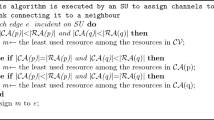Abstract
Cognitive radio (CR) technology enables opportunistic exploration of unused licensed channels. By giving secondary users (SUs) the capability to utilize the licensed channels (LCs) when there are no primary users (PUs) present, the CR increases spectrum utilization and ameliorates the problem of spectrum shortage. However, the absence of a central controller in CR ad hoc network (CRAHN) introduces many challenges in the efficient selection of appropriate data and backup channels. Maintenance of the backup channels as well as managing the sudden appearance of PUs are critical issues for effective operation of CR. In this paper, a prioritized medium access control protocol for CRAHN, PCR-MAC, is developed which opportunistically selects the optimal data and backup channels from a list of available channels. We also design a scheme for reliable switching of a SU from the data channel to the backup channel and vice-versa. Thus, PCR-MAC increases network throughput and decreases SUs’ blocking rate. We also develop a Markov chain-based performance analysis model for the proposed PCR-MAC protocol. Our simulations, carried out in \(NS-3\), show that the proposed PCR-MAC outperforms other state-of-the-art opportunistic medium access control protocols for CRAHNs.








Similar content being viewed by others
References
Akyildiz, I. F., Lee, W-Yl, & Chowdhury, K. R. (2009). Crahns: Cognitive radio ad hoc networks. Ad Hoc Networks, 7(5), 810–836.
Akyildiz, I. F., Lee, W.-Y., Vuran, M. C., & Mohanty, S. (2006). Next generation/dynamic spectrum access/cognitive radio wireless networks: A survey. Computer Networks, 50(13), 2127–2159.
Kalil, M. A. R., Liers, F., Volkert, T., & Mitschele-Thiel, A. (2009). A novel opportunistic spectrum sharing scheme for cognitive ad hoc networks. ECEASST, 17.
Kalil, M. A., Al-Mahdi, H., & Mitschele-Thiel, A. (2009). Analysis of opportunistic spectrum access in cognitive ad hoc networks. In Proceedings of the 16th international conference on analytical and stochastic modeling techniques and applications, ASMTA ’09 (pp. 16–28). Berlin, Heidelberg: Springer.
Kalil, M. A., Mitschele-Thiel, A., & Puschmann, A. (2012). Switch: A multichannel mac protocol for cognitive radio ad hoc network. In IEEE 76th vehicular technology conference (VTC2012-Fall), Qubec City, Canada, 09 2012.
Challapali, K., & Cordeiro, C. (2007). C-mac: A cognitive mac protocol for multichannel wireless networks. In Proceedings of IEEE DySPAN, pp. 147–157, 04 2007.
Abdullah-Al-Wadud, M., Kamruzzaman, S. M., Hamid, & Abdul, Md. (2010). An energy efficient mac protocol for qos provisioning in cognitive radio ad hoc networks. Radioengineering, 19(4), 567–578.
Le, L., & Hossain, E. (2008). Osa-mac: A mac protocol for opportunistic spectrum access in cognitive radio networks. In Proceedings of IEEE wireless communication and networking conference (WCNC 2008), pp. 1426–1430, 04 2008.
Wang, L.-C., Chen, A., & Wei, D. S. L. (2010). Full length article: A cognitive mac protocol for qos provisioning in ad hoc networks. Phys. Commun., 3(2), 105–118.
Hsu, A. C.-C., Wei, D. S. L., & Jay Kuo, C.-C. (2007). A cognitive mac protocol using statistical channel allocation for wireless ad-hoc networks. In Proceedings of IEEE wireless communication and networking conference (WCNC 2007). IEEE, pp. 105–110.
Xia, L., Pawelczak, P., Prasad, R. V., & Niemegeers, I. G. (2005). Cognitive radio emergency networksrequirements and design. In Proceedings of IEEE Int’l Symposium Dynamic Spectrum Access Networks (DySPAN), November 2005, pp. 601–606.
Xiaorong, Z., Lianfeng, S., & Tak-Shing, P. Y. (2007). Analysis of cognitive radio spectrum access with optimal channel reservation. IEEE Communications Letters, 11(4), 304–306.
Tumuluru, V. K., Niyato, P., Wang, D., & Song, W. (2013). Performance analysis of cognitive radio spectrum access with prioritized traffic. IEEE Transactions on Vehicular Technology, 61(4), 1895–1906.
Al-Mahdi, H., Kalil, M. A., Liers, F., & Mitschele-Thiel, A. (2009). Increasing spectrum capacity for ad hoc networks using cognitive radios: An analytical model. IEEE on Communications Letters, 13(9), 676–678.
Zhu, X., Shi, J., Yang, L., & Zhu, H. (2013). Spectrum capacity for ad hoc networks using cognitive radios: An analytical model. Wireless Personal Communications, 71(3), 2097–2109.
Miazi, Md. Nazmus S., Tabassum, M., Razzaque, Md. A., & Abdullah-Al-Wadud, M. (2014). An energy-efficient common control channel selection mechanism for cognitive radio ad hoc networks. Annals of Telecommunication, 1–18. doi:10.1007/s12243-014-0420-0.
Razzaque, Md A., Hong, C. S., & Lee, S. (2010). Autonomous traffic engineering for boosting application fidelity in wireless sensor networks. IEICE Transactions on Communications, E93–B(11), 2990–3003.
The Network Simulator NS-3. http://www.nsnam.org/. Accessed on : March 20, 2014.
Acknowledgments
This work was supported by Hankuk University of Foreign Studies Research Fund. Dr. Md. Abdur Razzaque is the corresponding author of this paper.
Author information
Authors and Affiliations
Corresponding author
Appendices
Appendix 1: Transition Probabilities
In this appendix, we derive the mathematical formulas for calculating the transition rates of Sect. 5.
where,
where,
where,
\(\delta _{9}\) is same as \(\delta _{8}\).
where,
where,
where,
where,
where,
where,
where,
where,
where,
where,
where,
where,
where,
where,
where,
\(\delta _{25}\) is same as \(\delta _{24}\).
where,
where,
where,
where,
where,
Appendix 2: Balance Equation
In this appendix the equations needed for calculating the balance equation is given.
Rights and permissions
About this article
Cite this article
Hossain, R., Rijul, R.H., Razzaque, M.A. et al. Prioritized Medium Access Control in Cognitive Radio Ad Hoc Networks: Protocol and Analysis. Wireless Pers Commun 79, 2383–2408 (2014). https://doi.org/10.1007/s11277-014-1990-x
Published:
Issue Date:
DOI: https://doi.org/10.1007/s11277-014-1990-x




